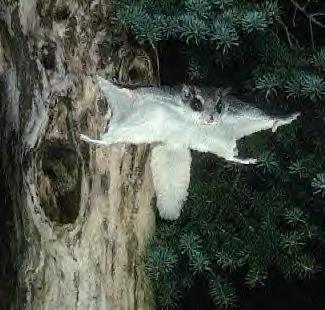|
SOUTHERN FLYING SQUIRREL
Glaucomys volans
HABITS AND HABITATS
 The so-called
Flying Squirrels do not actually fly, but glide by means of a furred, sheetlike membrane along the sides of the
body between the fore and hind limbs. Only two species occur in North America: the Southern Flying Squirrel is
found in extreme southeastern Canada, the eastern half of the United States, Mexico, and Central America. The Northern
Flying Squirrel is found mainly in Canada, Alaska, and the western and northern parts of the conterminous United
States. The so-called
Flying Squirrels do not actually fly, but glide by means of a furred, sheetlike membrane along the sides of the
body between the fore and hind limbs. Only two species occur in North America: the Southern Flying Squirrel is
found in extreme southeastern Canada, the eastern half of the United States, Mexico, and Central America. The Northern
Flying Squirrel is found mainly in Canada, Alaska, and the western and northern parts of the conterminous United
States.
Flying Squirrels are nocturnal animals, becoming active only after dark. They eat a variety of different foods
such as berries, fruits, acorns, and nuts. They will also feed on animal matter such as insects, nesting birds
and eggs, and the flesh of dead animals. Like other squirrels, flying squirrels often store food for the winter
months.
Flying squirrels nest primarily in tree cavities, especially abandoned woodpecker holes,
but may also construct summer nests of leaves, twigs, and bark. During the winter, many Flying Squirrels will often
den together.
Breeding takes place in January and February and again in June and July. Litters usually
range from 1 to 6 individuals with 2 to 3 being the average. The young are born blind and hairless with their eyes
and ears closed. By four weeks of age, the young are covered with hair and their eyes are open. They are weaned
by six weeks of age but remain with their mother until the next litter is born.
Southern Flying Squirrels are found primarily in mature hardwoods and mixed conifer-hardwood
forests, especially those with old growth trees which produce abundant food and plenty of cavities for nesting
and denning.
HISTORY
Southern Flying Squirrels are abundant throughout their range and are adaptable animals, often living close to
human residences. If there is a lack of suitable natural denning sites, flying squirrels will often take up residence
in attics or abandoned buildings, especially during the winter months. They are easily attracted to nesting boxes
and can often be found feeding from bird feeders at night. They can often be approached quite closely and are easily
observed at bird feeders as long as you move slowly and quietly. Flying squirrels are sometimes kept as pets, a
practice that is illegal without special captive permits.
 More Flying Squirrel Facts: More Flying Squirrel Facts:
- Actual encounters with humans are rare because flying squirrels are exclusively nocturnal
in their activity. They live in woods with nut or acorn-bearing trees, a water supply, scattered dead trees and
snags. They sometimes nest in attics. Autumn nights are best for observing flying squirrels because they are busy
gathering food for winter. Flying squirrels are less active during cold winter weather.
- Flying squirrels can be identified by their high-pitched, excited-sounding "cheeps"
often heard within the first several hours after sunset. They use these sounds to keep track of one another and
offer warnings. Sounds produced by flying squirrels sometimes exceed the upper limits of frequencies heard by human
ears.
- Flying squirrels feed on hickory nuts, acorns, wild cherry pits and other seeds. They
also eat dormant insects, lichens and fungi. In warmer weather, they eat various types of vegetation, including
mushrooms, persimmons, wild grapes and the bark of many hardwood trees.
- Though they do not hibernate, flying squirrels nest together in groups during winter.
They can reduce their metabolic rate and body temperature to conserve energy, and they benefit from one another's
radiant heat. Social reasons also encourage the behavior among related flying squirrels.
- The females are attentive mothers. They maintain several secondary nests to which they
can bring their young to keep them safe. A flying squirrel was once seen moving her young during a forest fire
and being singed in the process. Also, she will not hesitate to defend her young, even if is she is outnumbered
or if her foe is larger. Nests are made out of shredded bark and/or spanish moss.
- Baby flying squirrels are usually weaned when they are about six to eight weeks old.
The newly born young are usually about 2.5 inches long from head to tip of tail and weigh less than one-fifth of
an ounce. They are blind, pink and hairless. Their eyes open in about three weeks. The gliding membrane, however,
is already fully developed. They can live at least five years in the wild and 12 years in captivity.
- The gliding capabilities of the young develop quickly. By eight weeks they can execute
90-degree turns, lateral loops and other maneuvers like adults. Adults often make glides of up to 160 feet; the
record is about 100 yards.
- Their major nocturnal predators are owls and snakes, particularly rat and corn snakes
in the Southeast. Racoons also like to make prey of flying squirrels.
- The peak breeding seasons for southern flying squirrels are February through March and
August through October.
|